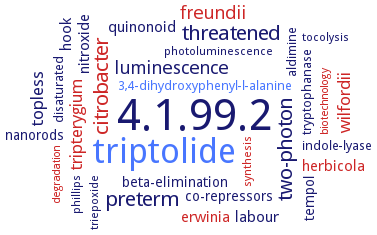4.1.99.2: tyrosine phenol-lyase
This is an abbreviated version!
For detailed information about tyrosine phenol-lyase, go to the full flat file.

Word Map on EC 4.1.99.2 
-
4.1.99.2
-
triptolide
-
citrobacter
-
threatened
-
preterm
-
two-photon
-
luminescence
-
freundii
-
topless
-
tripterygium
-
wilfordii
-
nitroxide
-
quinonoid
-
hook
-
labour
-
erwinia
-
herbicola
-
co-repressors
-
nanorods
-
tempol
-
beta-elimination
-
disaturated
-
3,4-dihydroxyphenyl-l-alanine
-
tryptophanase
-
aldimine
-
indole-lyase
-
phillips
-
tocolysis
-
triepoxide
-
synthesis
-
photoluminescence
-
degradation
-
biotechnology
- 4.1.99.2
- triptolide
- citrobacter
-
threatened
-
preterm
-
two-photon
-
luminescence
- freundii
-
topless
- tripterygium
- wilfordii
-
nitroxide
-
quinonoid
-
hook
-
labour
- erwinia
- herbicola
-
co-repressors
-
nanorods
-
tempol
-
beta-elimination
-
disaturated
- 3,4-dihydroxyphenyl-l-alanine
- tryptophanase
-
aldimine
-
indole-lyase
-
phillips
-
tocolysis
-
triepoxide
- synthesis
-
photoluminescence
- degradation
- biotechnology
Reaction
Synonyms
beta-tyrosinase, Fn-TPL, L-tyrosine phenol-lyase, phenol-lyase, tyrosine, TnaA, TPL, tyrosine phenol lyase, tyrosine phenol-lyase, tyrosine-phenol lyase
ECTree
Advanced search results
General Information
General Information on EC 4.1.99.2 - tyrosine phenol-lyase
Please wait a moment until all data is loaded. This message will disappear when all data is loaded.
evolution
the carbon-carbon lyases, tryptophan indole lyase (TIL, EC 4.1.99.1) and tyrosine phenol-lyase (TPL) are bacterial enzymes which catalyze the reversible elimination of indole and phenol from L-tryptophan and L-tyrosine, respectively. These pyridoxal 5'-phosphate-dependent enzymes show high sequence homology (about 40% identity) and both form homotetrameric structures. Pre-steady state kinetics with TPL and TIL show rapid formation of external aldimine intermediates, followed by deprotonation to give quinonoid intermediates absorbing at about 500 nm. The active sites of TIL and TPL are highly conserved with the exceptions of these residues: Arg381(TPL)/Ile396 (TIL), Thr124 (TPL)/Asp137 (TIL), and Phe448 (TPL)/His463 (TIL). The conserved tyrosine, Tyr71 (TPL)/Tyr74 (TIL) is essential for elimination activity with both enzymes, and likely plays a role as a proton donor to the leaving group.A unique feature of TIL and TPL is another strictly conserved lysine (Lys256 in Citrobacter freundii TPL) immediately preceding the pyridoxal 5'-phosphate-binding lysine, and hydrogen bonded to a water molecule bound to the monovalent cation. The mechanisms of TPL and TIL require both substrate strain and acid/base catalysis, and substrate strain is probably responsible for the very high substrate specificity of TPL and TIL. Both enzymes require a monovalent cation, either K+, NH4+, Rb+ or Cs+ for activity, with Na+ and Li+ giving little or no activity. The active site residues involved in PLP binding are highly conserved for both TIL and TPL. Sequence comparisons
metabolism
-
tyrosine phenol lyase catalyses the biosynthesis of L-tyrosine/L-DOPA from ammonium, pyruvate and phenolic substrates through the reverse of alpha- and beta-elimination reaction
physiological function
-
hyper-3,4-dihydroxyphenyl-L-alanine-producing strain by a mutant TyrR, an activator of tpl, whereby highest productivity is obtained for the strain grown under non-induced conditions, which is 30fold higher than that obtained for tyrosine-induced wild-type cells
additional information
essential catalytic residues are Tyr71, Thr124, Arg381, and Phe448. There are two quinonoid structures of the enzyme, relaxed and tense. In the relaxed structure, the substrate aromatic ring is in plane with the Cbeta-Cgamma bond, but in the tense structure, the substrate aromatic ring is about 20° out of plane with the Cbeta-Cgamma bond. In the tense structure, hydrogen bonds are formed between the substrate OH and the guanidinium of Arg381 and the OH of Thr124, and the phenyl rings of Phe448 and 449 provide steric strain. Structure of the active site of the TPL quinonoid complex with L-alanine and pyridine N-oxide, overview
additional information
the Ser51 residue interacts with the side chain amino group of Lys257 at the stage of C-alpha-proton abstraction. This interaction ensures the correct orientation of the side chain of Lys257 accepting the C-alpha-proton of the external aldimine and stabilizes its ammonium form. Ser51 takes part in formation of a chain of hydrogen bonds which is necessary to perform the transfer of the Calpha-proton to the C-4'-position of the leaving phenol group in the reaction with the natural substrate. Ser51 is necessary for efficient C-alpha-proton abstraction and its following transfer to the 4'-position of the leaving phenol group in the alpha,beta-elimination reaction of L-tyrosine


 results (
results ( results (
results ( top
top






